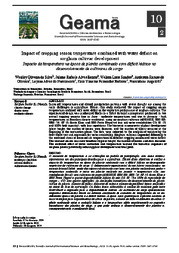Embrapa Semiárido
Publicações
Impact of cropping season temperature combined with water deficit on sorghum cultivar development.
Autoria: SILVA, W. O. da; BARROS, J. R. A.; SIMOES, W. L.; OLIVEIRA, A. R. de; NASCIMENTO, L. A. do; BARBOSA, K. V. F.; ANGELOTTI, F.
Resumo: Increased temperatures and altered precipitation patterns with severe drought are among the main challenges in agriculture. Hence, this study evaluated the impact of cropping season temperature combined with water deficit on the vegetative performance of sorghum cultivars. The experimental design was randomized blocks in a 2x6x4 factorial arrangement, performed in two annual cropping seasons (one in June -moderate temperatures; and one in January -high temperatures, in Brazilian climate conditions), using six sorghum cultivars (AGRI002E, BRS 506, BRS 716, SF 15, Santa Elisa, and BRS Ponta Negra) at four soil water availabilities (25, 50, 75, and 100% field capacity), with four repetitions. The biometric assessments of plant development (plant height, the number of leaves, stem diameter, and the number of tillers) occurred at the beginning of the maturation phase. The data were subjected to the analysis of variance by the Scott-Knott test and regression for water availability. Sorghum cultivars responded differently to the combined stress of increased air temperatures in different cropping seasons and water deficit. The warmest season was more beneficial to plant height, the number of leaves, and stem diameter. The combined effect of water restriction and temperature harmed the biometric responses of sorghum plants, potentially reducing plant development and final yield.
Ano de publicação: 2024
Tipo de publicação: Artigo de periódico
Unidade: Embrapa Semiárido
Palavras-chave: Abiotic stress, Climate change, Cultivares resilientes, Déficit hídrico, Estresse abiótico, Mudança Climática, Sorghum Bicolor, Sorgo

